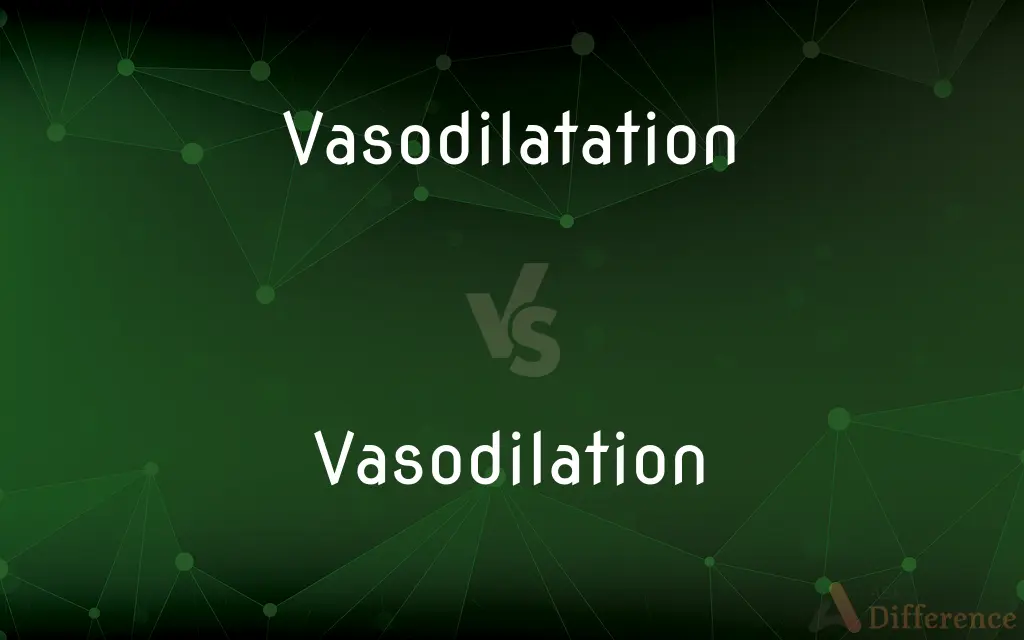Vasodilatation vs. Vasodilation — What's the Difference?
By Urooj Arif & Fiza Rafique — Updated on March 13, 2024
Vasodilatation emphasizes the process of blood vessel widening, whereas vasodilation refers to the same but is more commonly used in medical contexts.

Difference Between Vasodilatation and Vasodilation
Table of Contents
ADVERTISEMENT
Key Differences
Vasodilatation involves the relaxation of smooth muscle cells within blood vessel walls, leading to an increase in vessel diameter. This process is crucial for regulating blood flow and blood pressure. On the other hand, vasodilation, while denoting the same physiological phenomenon, is the term more frequently adopted in medical studies and healthcare discussions. It's associated with responses to temperature changes, exercise, inflammation, and certain drugs that aim to decrease blood pressure or increase blood flow.
While vasodilatation might be encountered in older texts or in certain academic contexts, emphasizing the action of dilating, vasodilation is favored in contemporary medical literature and discussions, highlighting its relevance in clinical settings. This preference illustrates the evolution of language within the scientific community and its impact on communication clarity.
The terms also reflect cultural and historical differences in medical terminology. Vasodilatation, with its -tatation ending, might be seen as more aligned with certain European linguistic traditions, whereas vasodilation, with its -lation ending, is more aligned with modern American and international English used in science and medicine.
In everyday health discussions, vasodilation is more likely to be recognized and understood by the general public, healthcare professionals, and students, owing to its prevalence in educational materials, medical literature, and popular health information sources. Vasodilatation, while correct, may be perceived as more formal or less familiar to non-specialists.
Comparison Chart
Definition
The process of widening blood vessels.
The process of blood vessels widening.
ADVERTISEMENT
Common Usage
Less common, more traditional or academic contexts.
More common, especially in medical contexts.
Linguistic Origin
Older, with a slight European linguistic influence.
Modern, with strong alignment to international English.
Implication in Medicine
Less frequently used in clinical settings.
Widely used in medical discussions and literature.
Public Recognition
May be less recognized by the general public.
More easily recognized and understood by laypeople and professionals alike.
Compare with Definitions
Vasodilatation
The expansion of blood vessels.
Vasodilatation can reduce blood pressure by increasing the diameter of blood vessels.
Vasodilation
Widening of blood vessels to increase flow.
Exercise induces vasodilation, enhancing muscle oxygenation.
Vasodilatation
A physiological response to warmth.
Vasodilatation in the skin leads to heat dissipation in warm environments.
Vasodilation
Important in both pathological and therapeutic contexts.
Vasodilation is a factor in inflammation and shock.
Vasodilatation
Involves multiple body systems.
Vasodilatation plays a key role in the body's thermoregulation process.
Vasodilation
A critical response to prevent overheating.
Vasodilation helps in dissipating excess body heat through the skin.
Vasodilatation
Triggered by various factors.
Certain medications cause vasodilatation to improve blood flow.
Vasodilation
Can be pharmacologically induced.
Nitroglycerin is used for its vasodilation effects in treating angina.
Vasodilatation
Can be a symptom or a therapeutic goal.
Vasodilatation can be induced during certain medical treatments.
Vasodilation
Affects various physiological processes.
Vasodilation is integral to regulating blood pressure and flow.
Vasodilatation
Dilation of a blood vessel, as by the action of a nerve or drug.
Vasodilation
Vasodilation is the widening of blood vessels. It results from relaxation of smooth muscle cells within the vessel walls, in particular in the large veins, large arteries, and smaller arterioles.
Vasodilatation
Dilatation of a blood vessel
Vasodilation
Dilation of a blood vessel, as by the action of a nerve or drug.
Vasodilation
Dilation or widening of the blood vessels.
Vasodilation
Dilation of blood vessels (especially the arteries)
Common Curiosities
Is vasodilatation the same as vasodilation?
While they describe the same physiological process, "vasodilation" is more commonly used, especially in medical contexts.
What is vasodilatation?
Vasodilatation is the process of blood vessels widening, allowing for increased blood flow.
What is vasodilation?
Vasodilation refers to the expansion of blood vessels, typically to improve blood flow or reduce blood pressure.
How does vasodilatation affect blood pressure?
Vasodilatation decreases blood pressure by increasing the diameter of blood vessels, thereby reducing vascular resistance.
What triggers vasodilation?
Vasodilation can be triggered by factors like heat, exercise, certain medications, and physiological conditions like inflammation.
Why is vasodilation important in medicine?
Vasodilation is crucial for treating various conditions, such as hypertension and heart disease, by improving blood flow and reducing blood pressure.
How do medications induce vasodilation?
Certain drugs, like vasodilators, directly relax blood vessel walls, leading to vasodilation and decreased blood pressure.
Can vasodilatation be harmful?
Excessive vasodilatation can lead to hypotension (low blood pressure), which may cause dizziness or fainting.
How does vasodilatation affect the heart?
Vasodilatation can reduce the workload on the heart by lowering systemic vascular resistance, thereby easing the heart's effort in pumping blood.
Can both terms be used interchangeably?
Yes, both terms can be used interchangeably, although "vasodilation" is preferred in most modern medical contexts.
What is the significance of vasodilation in thermoregulation?
Vasodilation plays a key role in thermoregulation by allowing increased blood flow to the skin, which helps dissipate heat from the body.
Are there any natural ways to promote vasodilation?
Regular exercise, a healthy diet rich in nitrate-containing foods (like beets and leafy greens), and maintaining optimal hydration can naturally promote vasodilation.
What role does vasodilation play in exercise?
During exercise, vasodilation increases blood flow to muscles, supplying more oxygen and nutrients.
How is vasodilatation measured or observed?
Vasodilatation can be observed through various medical imaging techniques, such as ultrasound, which can visualize changes in blood vessel diameter.
What is the difference in usage between vasodilatation and vasodilation?
"Vasodilation" is more widely used in contemporary medical discussions and literature, while "vasodilatation" is less common and may appear in more traditional or academic contexts.
Share Your Discovery

Previous Comparison
Teachers vs. Masters
Next Comparison
Garnish vs. GarnerAuthor Spotlight
Written by
Urooj ArifUrooj is a skilled content writer at Ask Difference, known for her exceptional ability to simplify complex topics into engaging and informative content. With a passion for research and a flair for clear, concise writing, she consistently delivers articles that resonate with our diverse audience.
Co-written by
Fiza RafiqueFiza Rafique is a skilled content writer at AskDifference.com, where she meticulously refines and enhances written pieces. Drawing from her vast editorial expertise, Fiza ensures clarity, accuracy, and precision in every article. Passionate about language, she continually seeks to elevate the quality of content for readers worldwide.
















































